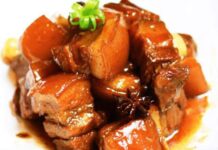Freezing meat is a common preservation method for many families. It allows you to reduce grocery shopping trips and always have meat ready for cooking. However, it requires planning ahead as you need to thaw the meat before cooking. Typically, the safest way to thaw meat is to transfer it from the freezer to the refrigerator overnight, slowly bringing it to a softer state. This method ensures safety by preventing bacterial growth. However, this approach may not work if you’re in a hurry.
Some people opt for thawing meat by soaking it in water. Each method has its pros and cons. For instance, using saltwater or vinegar can speed up the process, but there are concerns about how these liquids might affect the meat’s flavor. Thawing in a microwave is also a time-efficient method, but it can dry out the meat’s surface while the inside remains frozen.
A little-known trick to quickly and effectively thaw meat without compromising its quality involves using ice and metal objects.
Thawing Meat with Ice: A Clever Hack
For this method, you’ll need a large, heavy metal pan, a smaller metal pot or pan, and a bowl of ice-cold water.
Place the larger pan on a flat surface and put the meat on it. Fill the smaller pot with ice-cold water and place it on top of the meat, creating a metal-meat-metal sandwich. If your meat isn’t flat, you can prop the upper pan on the rim of the lower one or adjust the setup to ensure the bottom of the upper pan is in contact with the meat.
The thawing time will depend on the size of the meat. Typically, for thinly sliced meat weighing around 100-500 grams, it should take 8-15 minutes. Larger and thicker cuts will require more time, approximately 20-25 minutes.

The Science Behind This Method: Metal and Heat Transfer
Metal is an excellent heat conductor. The temperature difference between the upper and lower pans creates an optimal heat gradient, accelerating ice melting. This method also helps retain the meat’s moisture, a common issue with other thawing techniques.
To speed things up even more, you can add salt to the ice water in the upper pan. Salt lowers the freezing point of water, preventing it from turning slushy.
However, avoid using hot water, as it will partially cook the part of the meat in contact with the upper pan, affecting its flavor.
Remember, don’t leave thawed meat at room temperature for too long to prevent bacterial growth. Once the meat is soft, cook it immediately.
Never refreeze thawed meat. Before freezing, divide large cuts into portions suitable for a single meal. This way, you won’t have to thaw more than you need, and it prevents the meat from sticking together in the freezer. You can use food wrap to individually wrap portions before placing them in a container.
In summary, using metal pans and ice water is a clever way to quickly thaw meat while keeping it moist. Metal thawing trays are also available commercially for this purpose.
The Magic Behind Temperature Retention in Vacuum Flasks: Unveiling the Science of Hot and Cold Beverages
Introducing the trusted companion for those always on the move – the humble vacuum flask, or as some may call it, the mighty insulated water bottle. In recent years, it has become a staple for students, workers, and adventurers alike, thanks to its incredible ability to maintain the desired temperature of beverages for extended periods. Whether you prefer your drinks hot or cold, this trusty flask ensures your preferred beverage stays that way, defying time and temperature fluctuations.





































